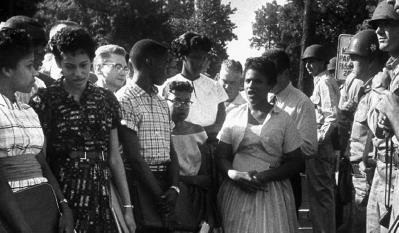The Warren Court (1953–69)Racial Discrimination |
How did the Warren Court respond to arguments that a state governor was not bound to obey its decision in Brown v. Board of Education? |
The Warren Court unanimously held in Cooper v. Aaron (1958) that state governors and legislators are bound under the Constitution—and its Supremacy Clause—to obey decisions by the U.S. Supreme Court. Quoting Marbury v. Madison, the Court wrote that “it is emphatically the province and duty of the judicial department to say what the law is.”
Arkansas governor Orval Faubus had ordered the Arkansas National Guard to prevent the integration of nine African American students into Little Rock’s Central High School in 1957—a defiance of a federal court order. This led to President Dwight D. Eisenhower sending in federal troops to ensure the protection of the students and the integration of the school.
The U.S. Supreme Court emphasized: “No state legislator or judicial officer can war against the Constitution without violating his undertaking to support it.”

